INTRODUCTION
The technology by which we observe distant objects today was originally developed by a German-Dutch optician, Hans Lippershey, in 1608. The leading-edge device later came to be known as binoculars and the eyepieces have since been largely modified. But the basic principle behind its operation remains the same. Although the original pair of binoculars was a combination of two pocket-sized telescopes, the modern design of binoculars we know and love today was perfected by an Italian scientist, Ignacio Porro, in 1854.

Ever since their inception, binoculars, and other sports optics, have been mainly produced in European countries, thanks to the technical superiority in the development of glass and metal alloys in Europe. This provided an edge to European optics manufacturers in terms of technology improvement. Consequently, binoculars, especially from Germany, became prevalent in armed forces and the general public alike throughout Europe in a relatively shorter period of time.
Over the years, users from all over the world have reached a consensus that binoculars made in Europe are of high quality. This agreement still holds to this day and binoculars sourced from Europe are still sought after by expert hunters, birdwatchers, wildlife observers, and law enforcement officials. Only binoculars produced in Japan have tried to catch up with German companies in terms of build quality and optical performance. In addition to quality, these binoculars are available at an affordable price unlike their European counterparts, which is why some users are slowly shifting towards Japanese binoculars.

In this article, we are going to list down the well-known European manufacturers of binoculars, and their popular products.
GERMANY
Germany tops our list of the most renowned sports optics manufacturers. Even before the onset of WWI, the world was already aware of the technical superiority of German engineering, which eventually led to the advancement of sports optics. The majority of high-end optics brands such as Leica, Zeiss, and Steiner, were all established in Germany. These companies adhered to innovation from the start and not even the Second World War inhibited their enthusiasm.
Since the end of WWII, the reputation and fan-following of German optics manufacturers have reached such a level, which is quite difficult to match up to for virtually any other country. While these brands are known for binoculars in the premium category, all manufactures also offer a variety of pocket-friendly devices, which is another reason why their products are being sold in more than 180 countries worldwide.
Presently, the following sports optics brands partly or fully produce binoculars in Germany:

Based in Wetzlar, Germany, Carl Zeiss AG or more simply, Zeiss is one of the three oldest optics giants that are headquartered in Germany; the other two being Leica and Steiner.
History and Abbe-Koenig Prisms
Being one of the oldest optics manufacturers, Zeiss was originally established as a small workshop by Carl Zeiss in 1846. The workshop initially oversaw the production of microscopes, but its focus shifted to the production of prisms and apochromatic lenses after Ernst Abbe and Otto Schott became a part of the company. It was at this point when Zeiss developed the innovative Abbe-Koenig roof prism which has revolutionized the sports optics industry.
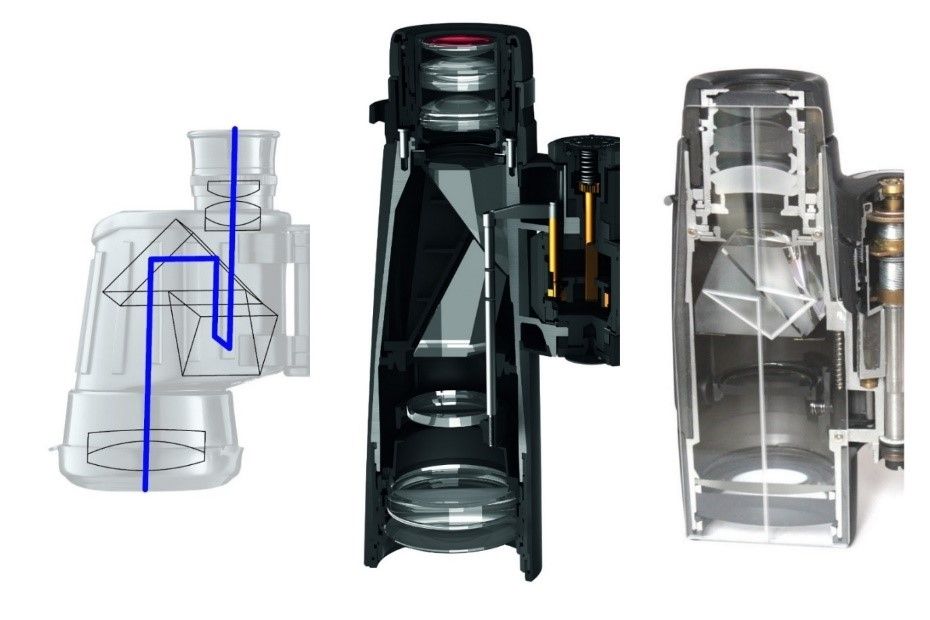
Under the Zwangsarbeiter program of Nazi Germany, several companies were forced to manufacture tools for the armed forces. Zeiss produced telescopes and other optical products for the army until its defeat in 1945, after which the company was divided into two; one part remained in Jena as VEB Zeiss Jena, while the latter was moved to West Germany as Zeiss-Opton Optische Werke in Oberkochen.
Zeiss in Wetzlar
The sports optics line from Zeiss has been produced entirely in Wetzlar, Germany since 1968. The Wetzlar factory was originally owned by the optical instruments producer Hensoldt AG, but Carl Zeiss acquired the facility over the years after initially obtaining a small partnership in 1928. In addition to Wetzlar, Zeiss also invested in MOM (Hungarian Optical Works) in the 1940s before completely acquiring its Mátészalka factory in 1992. Until 2007, the Hungarian factory was known as one of the largest lens producers in Europe with over 220 employees.
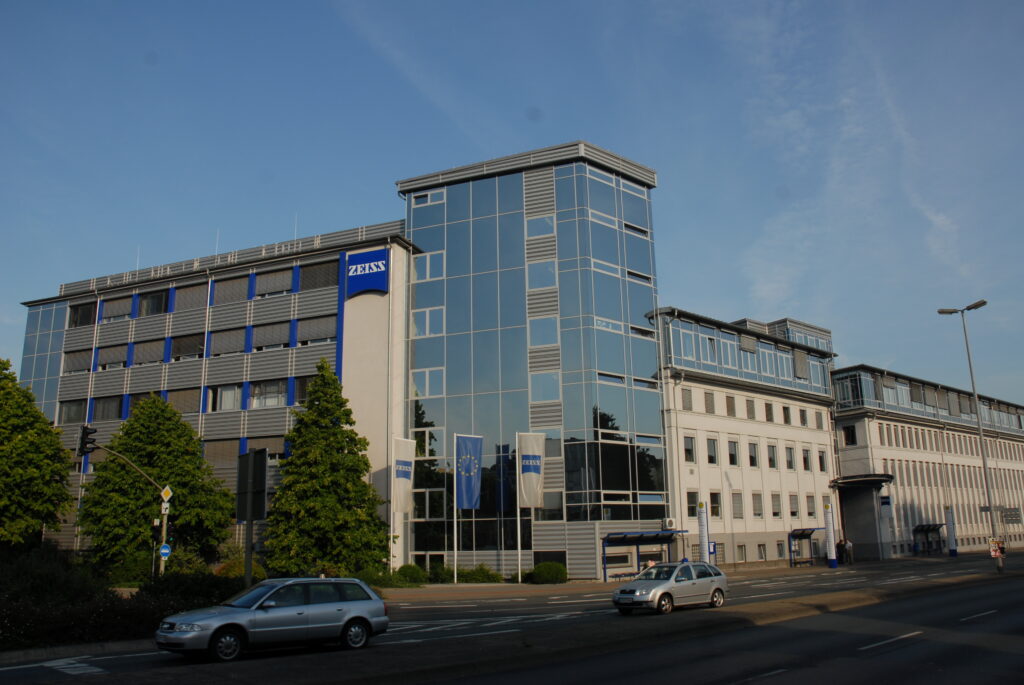
Binoculars Series
Zeiss currently offers three premium binoculars, all of which are produced in Wetzlar. First is the Conquest HD series that includes high-end binoculars with up-to-date technical features, such as Schott HT lenses, Abbe-Koenig prisms, multi-layer T* and LotuTec coating, and rubber armour.
Next is the Victory SF series, which touts the contemporary SmartFocus system from Zeiss alongside other flagship specifications. The SF system flaunts a large focus wheel placed ergonomically at the center, enabling users to comfortably hold and adjust the focus with either hand. Furthermore, the SF binoculars come up with an open-bridge design for added comfort while holding the device.
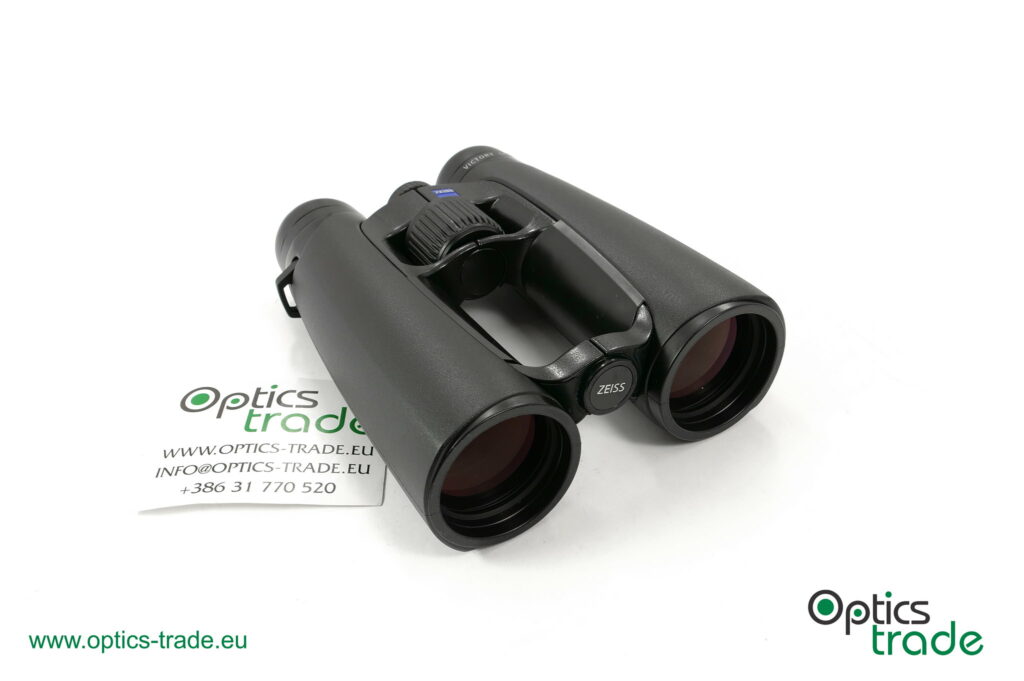
The last German-made series from Zeiss is the Victory HT. These binoculars are made to be used in the darkest of dawns and dusks with minimal lighting. The large 54 mm objectives offer up to 95% light transmission, which makes these binoculars the paramount choice for observing nature, especially during the twilight hours.

The “Made in China” Zeiss Terra ED binoculars are designed to provide an entrance to the Zeiss ecosystem. Although these binoculars are affordable, they still offer a fair viewing experience compared to other binos in their price range.
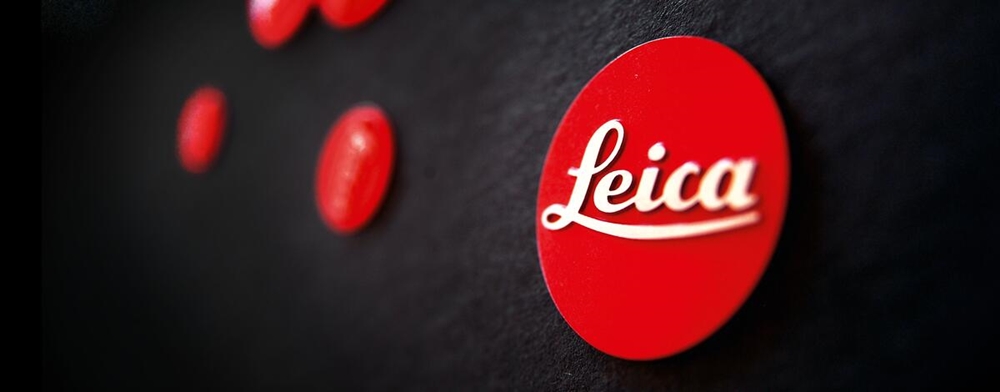
Leica is a Germany-based optics manufacturer, which rose to prominence with the introduction of hand-held cameras just before the advent of the First World War.
Brief History
Established in 1849, Leica was originally called Optische Institut and the small Wetzlar-based factory focused on the commercial production of microscopes. The business reached its peak by the 1900s, when the annual capacity grew to 4000 microscopes. Continued success inspired the owners to expand the product line and in 1907, the factory rolled out its first binocular “Binocle 6×18”. However, the production of binoculars was short-lived.
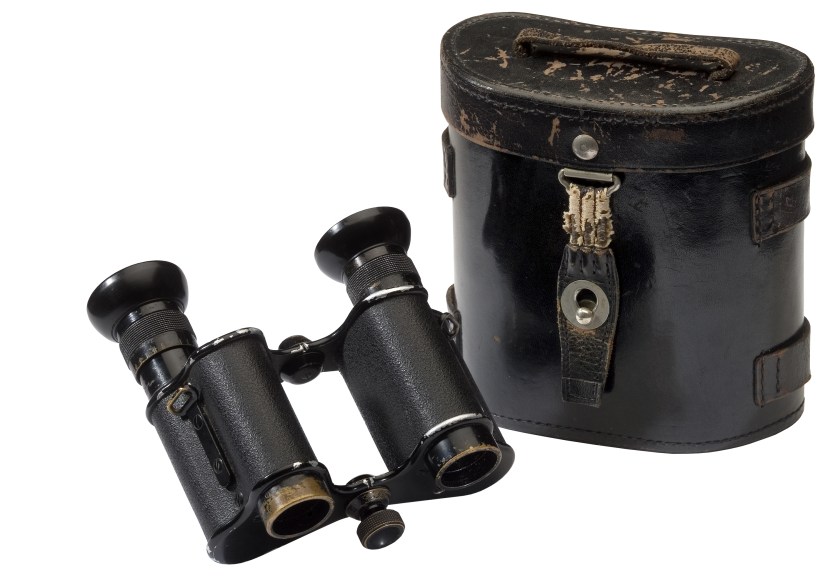
Working for over two years on his dream of the “hand-held camera”, Oskar Barnack, a factory employee, successfully invented the prototype of his portable camera in 1913. The “UR-Leica” camera used a 35 mm film for still photography and became an instant hit when Ernest Leitz took it on his tour to America. The rapid popularity of the prototype motivated the company to introduce improved versions in the following years; the company was subsequently renamed Leica. Following the events of WWII, Leica resumed the production of binoculars with the Trinovid series, which later flew to the moon in the Apollo mission in 1969. Since then, Leica has produced a series of binoculars which are popular all over the globe.
Binoculars Series Produced in Wetzlar, Germany
In 2014, Leica AG inaugurated a new factory location in Wetzlar to mark 100 years of the invention of the first portable camera. In addition to a world-class manufacturing facility, the new site includes attractions, such as Ernest Leitz museum, Leica Academy of Photography, Leica Store, and a hotel. The factory mainly focuses on the production of sophisticated cameras, but also incorporates manufacturing of some sports optics products.
The following Leica binoculars are produced in Germany:
-
Noctivid
The Noctivid is Leica’s flagship binoculars series with incredible features, such as a lightweight alloy construction, open-bridge hinge design, Schott HT glass optics, and multi-layer optical coating. Additionally, the outer casing is enclosed in a rubber armour for added protection against unwanted damage.
-
Ultravid HD+
Before Noctivid, the all-rounding Leica binoculars were Ultravid HD+. This series exhibits many high-end specifications, such as a magnesium outer casing, Schott HT glass, and rubber covering for a comfortable grip and protection. With Titanium-alloy material for the center hinge mechanism, these binoculars are made to last forever.
-
Duovid
The Duovid series is the ultimate illustration of Leica’s optical prowess combined with dual magnification. Typical zoom binoculars usually suffer from optical mediocrity due to an increased number of moving optical components. To overcome this issue, Leica has kept the zoom capability to two magnifications and has used optical components of exceptional quality. The Duovid binoculars have been discontinued by Leica, but they are available in limited quantity at Optics Trade.
Binoculars Series Produced in Portugal
Several models of Leica binoculars, along with some riflescopes and digital cameras, are produced in a factory in Porto, Portugal. Originally designed to produce microscopes in 1973, the workshop has seen several expansions and renovations over the years to accommodate the production of binoculars and cameras. Presently, the Leica Geovid, Trinovid HD, Ultravid, and Monovid binoculars are assembled in Portugal.
Another key player in the European sports optics market is Steiner, which was established by Karl Steiner in the aftermath of WWII. Since its inception, the company has remained at the forefront of German engineering and has remained a major supplier of military-grade optics to the armed forces of several countries. While the brand offers several models of riflescopes, spotting scopes, and battle sights, only its binoculars have retained a comparatively large market share since the start. Steiner Optics was acquired by Berretta Holding Group in 2008. Known as the largest and oldest weapons manufacturer, the Berretta group has stakes in over 32 different companies, including Steiner and Burris Optics.
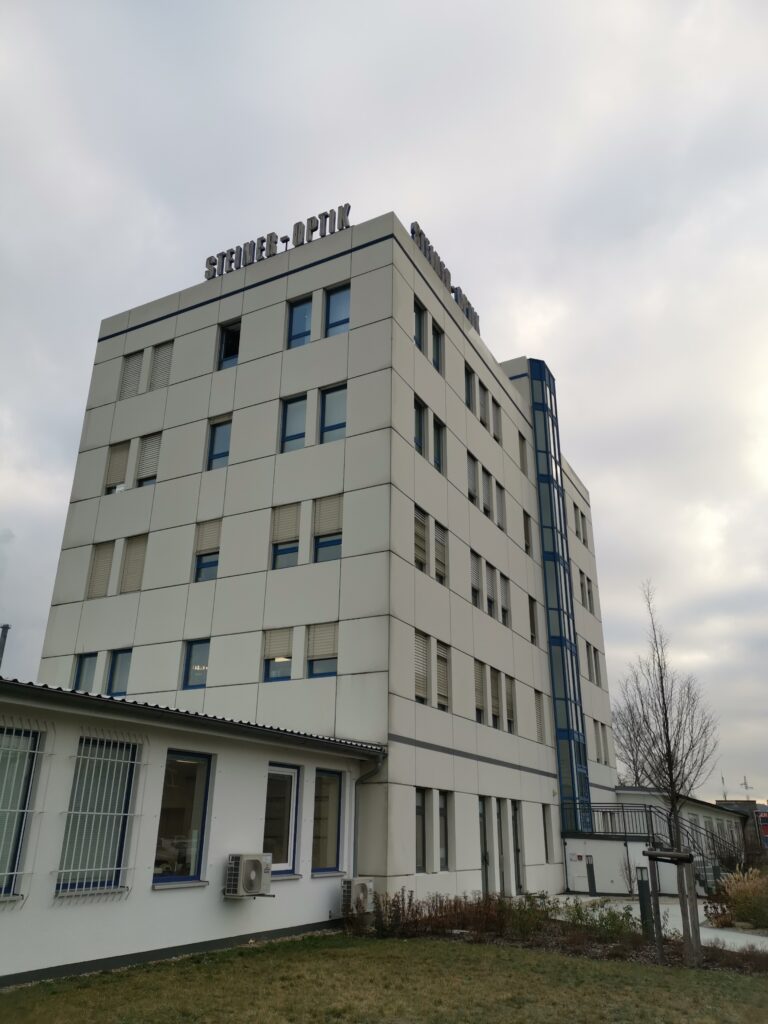
Bayreuth Production Facility
The headquarters of Steiner Optics ha s been in Bayreuth, Germany since 1947. The main building houses all manufacturing facilities on the ground floor. The shop floor incorporates computer-controlled machining equipment for producing metal and glass components. Although the use of modern machinery ensures the achievement of precise tolerance requirements, the quality control checking at Steiner is very strict. Both the individual parts and final products are thoroughly checked at each stage of the manufacturing process for inconsistencies.
Business areas such as planning, marketing, and sales departments are located on the floors above the production facility. There is also an after-sales service department on the ground floor that deals with repairs and replacements claims. Steiner has a vast network of product distributors throughout the world where users can make purchases and claim a warranty for malfunctioning devices.

Binoculars Made in Germany
Most of the Steiner binoculars are produced in Bayreuth, Germany, and production of only the affordable models are outsourced. All German-made binoculars from Steiner carry the “Main in Germany” branding as well as a 30-year warranty.
The following binoculars are presently manufactured in Germany:
-
Commander
The Commander series comprises 7×50 binoculars that are specially designed to be used in marine environments. Specs, such as rubber armour, corrosion-free polycarbonate casing, and moisture-repellent glass coatings are the main highlights of the Commander binoculars, along with a built-in compass for better navigation and sightseeing. All models in this series come in a Porro-prism design.
-
Nighthunter
One of the problems experienced hunters come across is insufficient light. To counter this issue, the innovative Nighthunter binoculars from Steiner are made to be used in minimal lighting conditions. Nighthunter binos feature the Porro-prism technology, which is applauded for better light transmittance compared to roof prism binoculars. The optical performance is further enhanced by the use of a multi-layer coating so that hunters can find camouflaged animals even in the darkest of dawns and dusks.

-
Ranger xTreme
Made for extreme hunting, the Ranger xTreme series features one of the highest fields of view of any binoculars found in this price range. To aid in quick focusing, this series is also equipped with a large focus wheel in the center which requires minimum travel to adjust from a close distance to infinity. Additionally, the outer casing is covered with a non-slip NBR rubber armour which provides a comfortable grip and protects against hard falls. These specs make Ranger xTreme the ultimate companion for wildlife hunting.

Outsourced Binoculars
Entry-level binoculars from Steiner that do not require intricate manufacturing and cost under 500 € are usually outsourced from an undisclosed location. Since Steiner produces all Porro prism models in-house, the outsourced models mainly feature roof prisms, and the signature “Made in Germany” is absent.
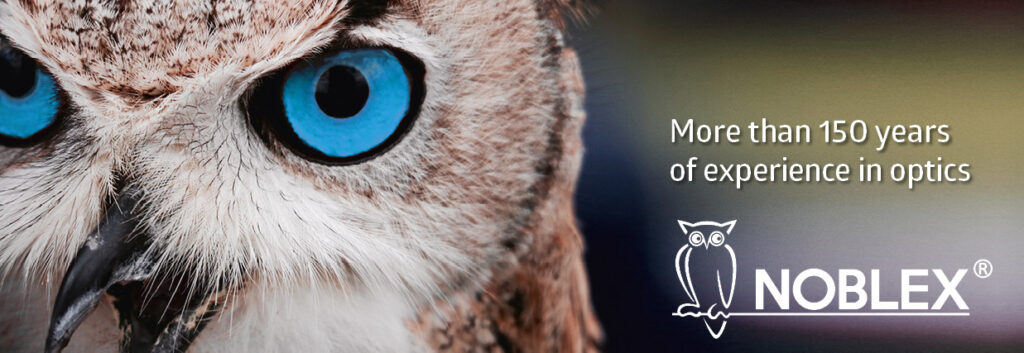
Noblex is a manufacturer of high-quality sports optics equipment and is located in Eisfeld, Germany. Formerly known as Docter Optics, Noblex currently manufactures binoculars, spotting scopes, rifle scopes, and red dot sights.
Aftermath of WWII
While the Noblex brand came into being in 2016, the company was originally founded in the years following the reunification of East and West Germany. The Second World War left Germany divided into two parts, which subsequently affected many German manufacturers that had a presence in multiple cities. Carl Zeiss AG was one of the affected companies, which was consequently dismantled into two parts, namely VEB Carl Zeiss Jenoptik and Carl Zeiss Wetzlar.
Eisfeld Factory and Docter Optics
In the following years, the demand for Zeiss products grew exponentially and another factory was set up in Eisfeld, Germany in 1952 to increase the production capacity. This move was successful and the combined annual production rose to 300,000 units. When East and West Germany were historically unified in 1991, the two Zeiss plants in Wetzlar and Jena were also reunited. The Eisfeld location was sold to Bernhard Docter, who renamed the factory Docter-Optik-Eisfeld. Docter became successful for a small period before it filed for bankruptcy in 1997 and was subsequently acquired by Analytik Jena.
Acquisition by Noblex GmbH
From 1997 to 2016, Analytik Jena kept the Docter brand alive due to its popularity among fans from all over Europe. In May 2016, Analytic Jena sold the Eisfeld plant to Noblex GmbH, which has since rebranded the Docter products, such as binoculars, riflescopes, and spotting scopes to Noblex Sports Optics. The new management is keen to reduce the number of German-made products to maximize profit margins. To sustain optical performance across all devices, optical components for all Noblex binoculars are made in Germany.

Binoculars Produced in Germany
Following binoculars are made in Germany:
-
B/GA
B/GA is a highly-functional set of binoculars that uses a lightweight magnesium alloy for its main housing. The robust housing is further covered with non-slip rubber armour to protect the internals against accidental falls. The B/GA is equipped with multi-layered German optics, especially Abbe-Koenig prisms, which provide captivating views of nature and wildlife even in minimal light. With 7×40 and 10×42 configurations, the B/GA is the go-to binoculars for every occasion.
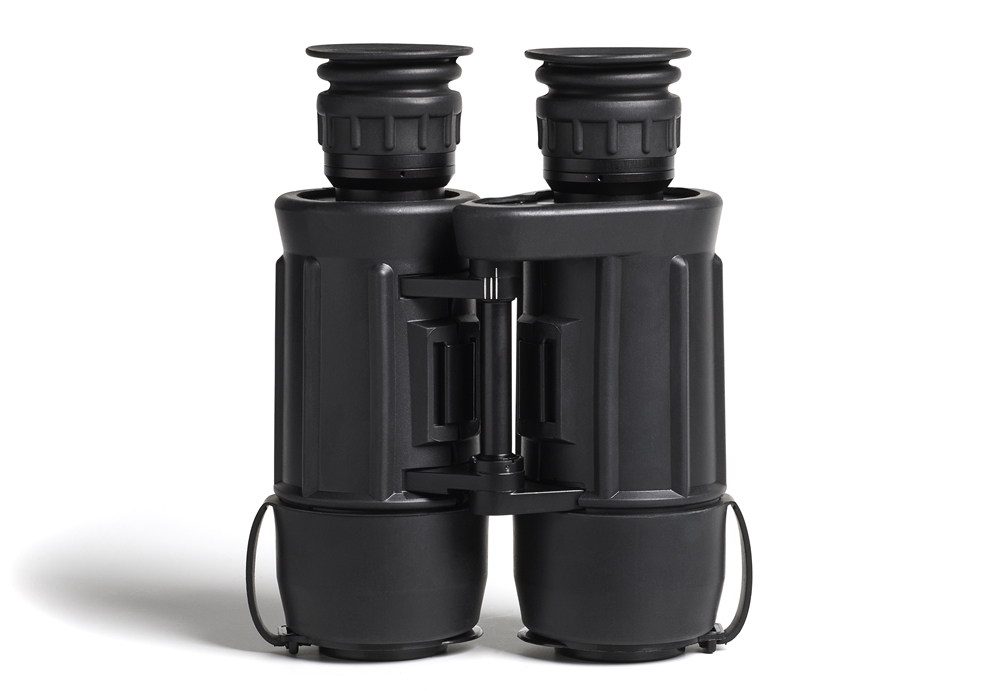
-
Compact
The Compact binoculars from Noblex are an ultra-portable device that uses a double-hinge design to occupy minimal space in a stowed position. Despite their compact size, the Compact exhibits German-engineered optics with phase correction coating to provide impressive optical imaging. Other specs include rubber armour and adjustable eyecups.

-
Noblex Mono
Ever wondered if a monocular could deliver the spatial viewing experience of a pair of binoculars? Now, with the Noblex Mono, it is possible. Despite its insignificant size and small 80 g weight, it features a Porro prism design. Additionally, the Mono comes with a 21 mm objective and 8x magnification, which is appropriate for most mundane activities.
Outsourced Binoculars
To reduce overheads, Noblex outsources all budget binoculars from China. The affordable models include the Noblex Vector and Inception series, both of which are equipped with German optics for high performance. Additionally, the Vector binoculars feature an open-hinge design, while the Inception series comes in a polycarbonate housing instead of metal.

Blaser is a distinguished arms manufacturer based in Isny Allgau, Germany. Blaser was founded by Horst Blaser in 1957, making it one of the youngest rifles and shotguns manufacturers in Europe. Since then, the company has produced a variety of weapons for the tactical and hunting markets throughout Europe and North America.
Blaser Sport Optics
Blaser officially entered the sports optics industry in 2017, after acquiring Minox and several other manufacturers, such as GSO, Mauser, Liemke, and J.P. Sauer & Sohn to form the Blaser Group, which is presently stationed in Isny Allgau. Up until February 2020, the sports optics products from Blaser were produced in the Minox factory in Wetzlar, Germany, but the company has shifted its manufacturing operations to Isny, where it will have an extensive exchange with other members of the group. Blaser is one of the few companies to make their complete range of binoculars in Germany.

-
Blaser Primus
Presently, the Blaser group only produces the Primus series binoculars. Primus binoculars are fitted with modern features, such as a robust magnesium housing, armoured rubber coating, phase-corrected BAK4 Abbe-Koenig prisms, low-dispersion (ED) glass lenses, and a tripod mounting option for day-long excursions. The binoculars are also equipped with Colour and Contrast Coating for increased light transmittance and SLP coating for aberration reduction.
-
MINOX

Minox is a renowned camera and a sports optics maker that originates in Wetzlar, Germany in 1945. Originally established as a manufacturer of hand-held cameras, the company quickly gained recognition as a maker of impressive spy cameras. The company was briefly owned by Leica Camera AG from 1996 to 2005 following a bankruptcy.
It was not until 2000 when Minox formally expanded its product line to include sports optics products, mostly riflescopes, binoculars, spotting scopes, and night vision equipment. In a way, Minox has followed a business pattern similar to that of Leica, both of which started their operations with imaging devices and expanded to include sports optics. In 2013, Minox was acquired by the German arms manufacturer Blaser. Since then, the company has produced several products for Blaser in its Wetzlar factory. In February 2020, a joint decision was made to shift the manufacturing operations of Minox to Isny Allgau, where the remaining members of the Blaser Group are based.
Minox offers several binoculars in premium, range-finder, armoured, and compact categories.

-
X-HD
X-HD are the only binoculars from Minox to be assembled in Germany. This model packs several high-end features, such as an open-bridge hinge design, phase-corrected roof prisms, extra low-density (ED) glass lenses, adjustable eyecups, and IPX 7 waterproof casing. The lenses are covered with multi-layer coating for better light transmittance and protection against abrasion.
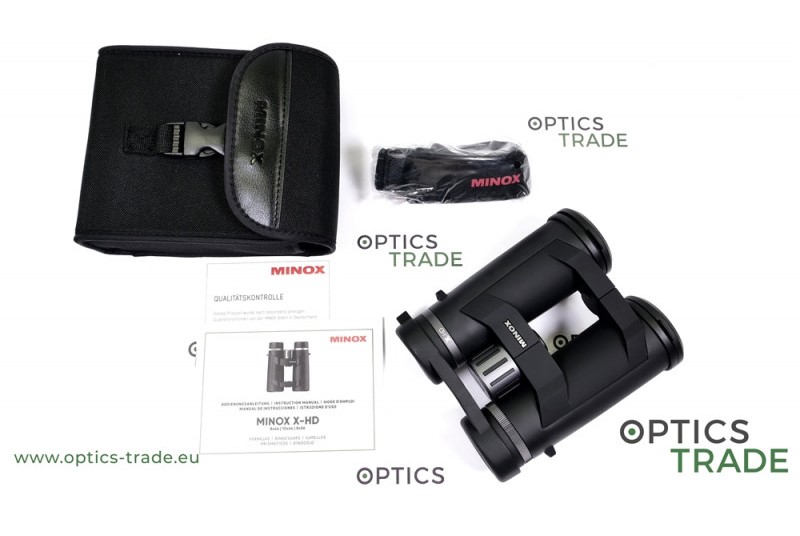
-
X-Range
The X-Range variant is equipped with a high-end laser rangefinder for precise range measurements of wildlife up to 1600 meters. Other features of the X-Range series include multi-coated ED glass lenses, phase-corrected roof prisms, adjustable eyecups, and a robust magnesium housing with IPX 7 waterproofing. This series of binoculars is however outsourced and not produced in Germany,
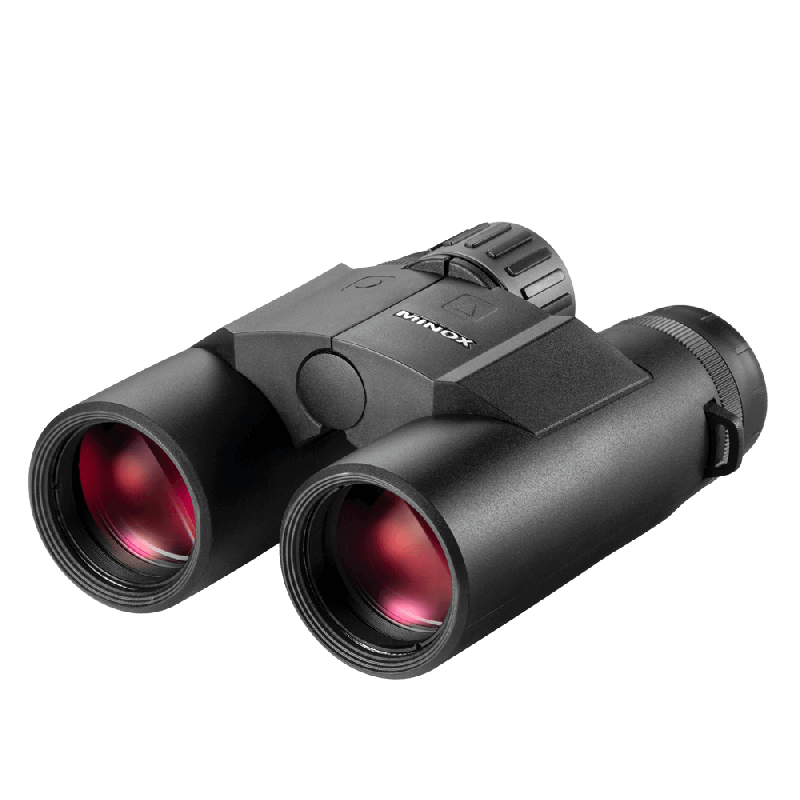
-
X-Active
X-active are all-rounding binoculars that are designed for use in virtually any situation. In addition to premium optics and waterproofing, the X-active is made of a rugged Aluminium housing for added protection. Also, it offers a large field of view for all configurations, something which is hard to find in outsourced binoculars. These binoculars are produced in Asia.
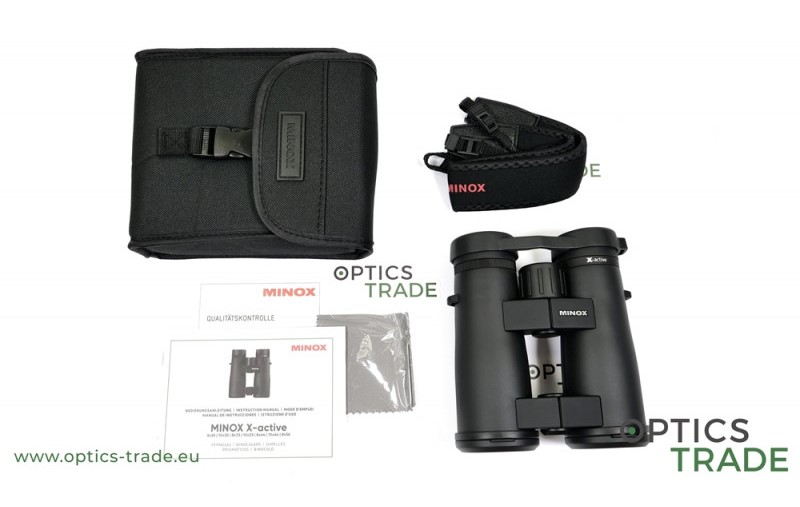
-
X-RAPID
Available in a unique 7.5×44 configuration, the durable X-RAPID binoculars are designed to be used in the most challenging of situations. This variant is equipped with an individual ocular focus system, which allows users to control the focus of each barrel separately. Additional features include phase-corrected prisms, light polycarbonate housing, adjustable eyecups, and an open-bridge hinge. This series of binoculars is however outsourced and not produced in Germany,

-
X-Lite
X-lite binoculars are designed to be inexpensive with just the right amount of features for entry-level users. Even at an affordable price, Minox has not compromised on binocular essentials, such as built quality, IPX 7 waterproofing, lens coatings, and adjustable eyecups. This series of binoculars is however outsourced and not produced in Germany,
-
OPTOLYTH
Optolyth is one of the first German producers of binoculars and telescopes. Founded in 1856, the same era as that of Leica and Zeiss, the company has produced numerous variants of binoculars, telescopes, and spotting scopes.
History
Optolyth started its production in Nuremberg, Germany, but has since shifted its manufacturing operations to Sorg (Wendelstein) following a merger with Sill Optics in 2004. Optolyth is one of the few remaining German makers to engineer all binoculars in-house. As a result, all manufacturing processes take place in a strict atmosphere with special attention given to the quality of raw materials used for optics and housing. Not to mention, the company uses CNC equipment for all machining processes.
Binoculars Series
In the binoculars section, the company currently offers three models. ViaNova and Royal binoculars are equipped with high-contrast optics, Ceralin-plus-Multicoating, rubber armour, a central focusing system, and adjustable eyecups. Sporting, the entry-level model, is also packed with rubber armour, a splash-resistant design, and adjustable eyecups. The key difference between Optolyth and other manufacturers is that the former uses Argon for purging, which is considered more efficient for fog and waterproofing.
AUSTRIA
Austria is home to two renowned sports optics producers, both of which have a long history.

If there is any pair of binoculars that can match the quality standards of German engineering, it is Swarovski Optik.
History
Founded in 1949, the company has a long history of producing high-quality binoculars, rangefinders, and riflescopes. The parent company, Swarovski, was established in 1895 in Tyrol, Austria as a crystal-cutting business, and has remained with the family ever since. The company has since become one of the biggest employers in Europe with over 34,000 employees. The success of the crystal business inspired the owners to introduce similar products, including sports optics. This later became the foundation of Swarovski Optik, which now sells products in more than 80 countries.

Patents
Given the number of years since Swarovski Optik has existed, the company has patented several specs for the sports optics industry. To name a few, wrap-around grip (open-bridge), spotting scopes with dual eyepieces, SWAROAIM inclinometer, SWAROVISION flat field lenses, SWAROLIGHT auto-illuminating reticles, SWAROBRIGHT, SWAROTOP lens coating for improving light transmittance, and SWARODUR and SWAROCLEAN lens coatings for protection from dirt and abrasion.
Binoculars
Unlike many European manufacturers, Swarovski Optik binoculars are all designed and manufactured in-house in Tyrol, Austria.
-
EL
The EL series are flagship binoculars that are filled with high-tech specs, for instance, premium HD fluoride lenses, phase-corrected prisms, premium lens coatings, open-bridge hinge, and adjustable eyecups. These features make it an all-rounder device for virtually all circumstances.

-
NL Pure
The NL Pure is the latest inclusion to the Swarovski line of binoculars, having been released in September this year. The NL Pure binoculars include all the technical specifications of the flagship EL series, in addition to a center-mounted focusing wheel and one of the largest fields of view, 159 m /1000 m, available in the 42 mm segment.
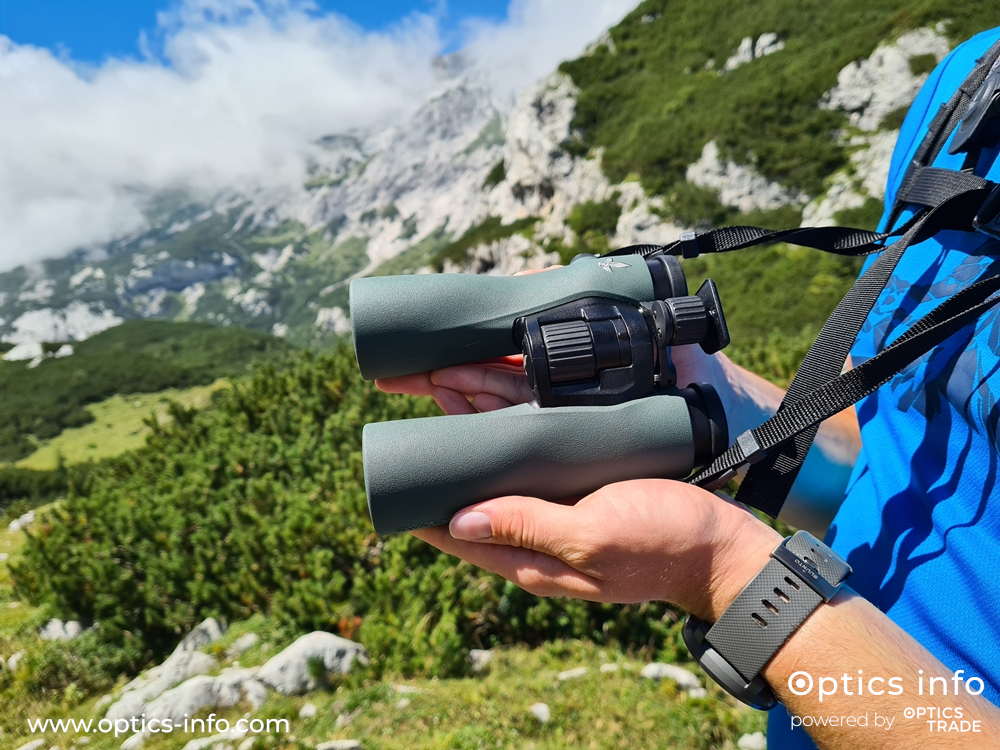
-
EL Range
As the name suggests, the EL Range is the rangefinder version of the original EL series with all the premium nitty-gritty. The built-in laser rangefinder system is capable of capturing distance and angle measurements of up to 1,375 meters with a click of a button. EL Range is available in greyish black or orange colours.

-
SLC
The SLC series is made to remain functional indefinitely thanks to the robust construction and durable central focusing mechanism. Additionally, the device is equipped with premium optics and protective coatings for unparalleled protection against rocky terrain and harsh weather. SLC 42mm binoculars were discontinued in 2020.
-
CL
The CL series features compact binoculars for everyday companionship. The CL-Pocket models come in a relatively small size and double hinge, which means they can be carried in jacket pockets during day-long excursions. The CL series is available in four variants, CL Pocket, CL Pocket Mountain, CL Companion, and CL Companion NOMAD.
-
Habicht
In contrast to other binoculars on this list, the Habicht includes the classic Porro prisms instead of the versatile roof prisms. Since Porro prisms are known for high light transmittance and spatial viewing, the Habicht provides incredibly bright and high-contrast views of objects even in low light.
-
KAHLES

KAHLES is an Austria-based manufacturer of riflescopes, red dot sights, and binoculars, which rose to prominence for its high-end riflescopes.
History
Now a part of Swarovski Optik, KAHLES was founded in 1898, as a result of a merger between the Simon Plossl Company and Karl Fritsch’s workshop in Vienna, Austria. Originally established to produce binoculars, the success of TELORAR and HELIA riflescopes steadily outshined the demand for binoculars, which ultimately prompted the owners to halt their production and continue with riflescopes. The company has since tried their hands at manufacturing binoculars from time to time without much success.
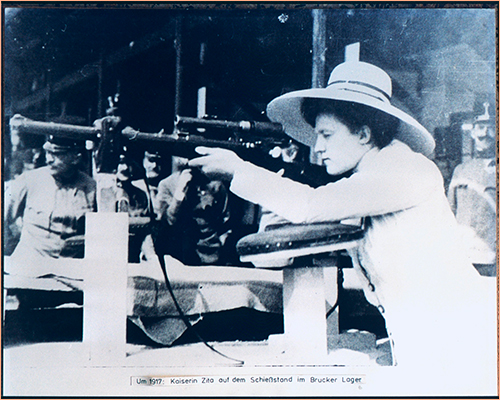
In 1974, KAHLES was incorporated into Swarovski Group’s sports optics branch, Swarovski Optik. The popularity of KAHLES convinced the management at Swarovski to keep the KAHLES brand and the rest is history.
Binoculars Series
As of today, KAHLES offers two variants of binoculars, Helia and Helia RF, both of which are outsourced from Japan and China respectively. Both binoculars are fitted with a light-weight housing, high-end optics, protective and performance lens coating, adjustable eyecups, and rubber armour for worry-free viewing. The Helia RF, unveiled in 2018, is equipped with an advanced rangefinder which is capable of measuring distances up to 1500 m. Both Helia and Helia RF also come with a handmade leather neck-strap, making them the perfect choice for hunting and bird watching.
The move to the outsourcing business model keeps the profit margins higher, while the company can focus on their main products, the K and Helia series riflescopes. The riflescopes, rangefinders, and hunting sights are produced in a high-tech KAHLES factory in Guntramsdorf, Lower Austria.
CZECH REPUBLIC
Presently, Meopta Optika is the only optics manufacturer based in the Czech Republic.

Based in Prerov, Meopta is one of the key players in the European sports optics industry. The company produces some of the best optical and opto-mechanical devices, which are on par with German quality.
History
Like KAHLES, Meopta Optika came into being as the outcome of a merger between two nationalized firms, C. P. Goerz and Optikotechna, in the aftermath of WWII. Before the merger, both businesses had a long history of producing optical equipment, which included binoculars, movie camera, field glasses, and lenses for various purposes. The two companies also sold optical devices to armed forces at some point before unification.

Being a national company from the start, Meopta was ultimately privatized in 1991. The company has one of the largest optics manufacturing setups in the whole of Europe and employs over 2,400 people in various capacities. Additionally, the factory uses modern software and machining equipment for all manufacturing processes. The enormous production facility in Prerov was aimed to keep the majority of research, design, and development operations in the Czech Republic.

Binoculars Series
All Meopta binoculars are assembled in the Prerov factory.
-
MeoStar
MeoStar is Meopta’s flagship series of binoculars, which packs premium features, in particular: Meopta’s signature MB5501 ion-assisted lens coating, phase-corrected prisms, Nitrogen-purging, robust magnesium-alloy construction, armoured rubber covering, and MeoShieldTM coating for protection against abrasion.
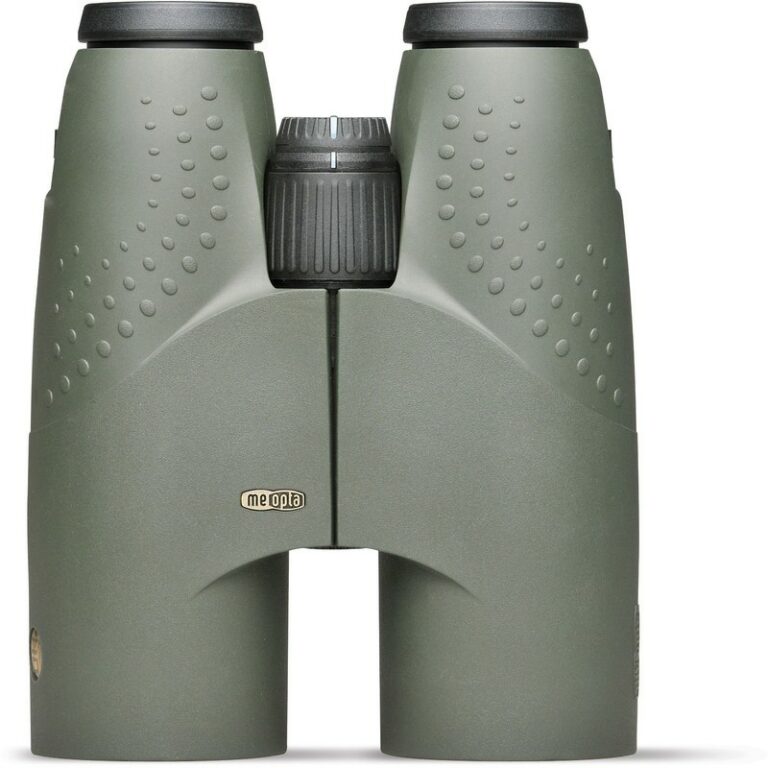
-
MeoPro HD
An affordable version of the MeoStar, the MeoPro HD offers virtually all high-end features of the flagship binoculars. Even at a reasonable price, the built quality and optical performance of this variant are surprisingly comparable with the MeoStar binoculars, making it a good choice for novice hunters and bird watchers.
-
Optika HD
Launched in August 2019, Optika HD is the latest addition to Meopta’s range of binoculars. Partly manufactured in the Philippines, this variant features a modern look with many of the premium specs offered by the manufacturer, such as phase-corrected roof prisms, high-fidelity lenses, lightweight magnesium housing, and rubber armour.

-
MeoRange HD
The MeoRange series is popular for its unparalleled viewing experience and advanced laser rangefinder system which can easily measure distances up to 1500m. The amazing optical performance is a result of fluoride lenses and multi-coatings, such as MB5501, MeoLux, and MeoDrop which also lens surfaces against bad weather.
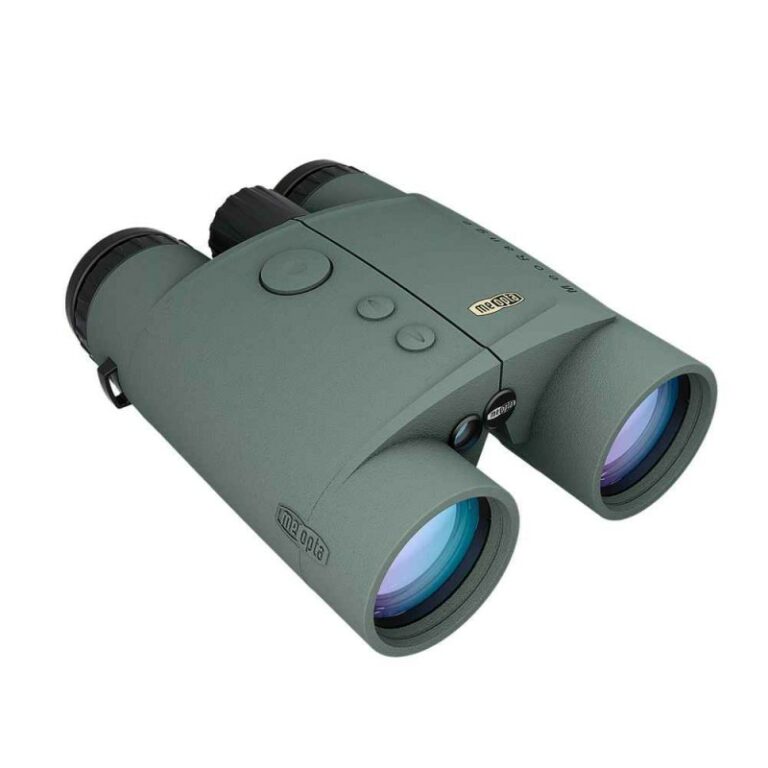
-
MeoSport
A binocular line up is incomplete without an entry-level model. Despite its compact size, MeoSport features high-performing optical components with an incredible eye relief of 18 mm. This variant is designed to be carried easily in pockets and comes only in an 8×25 configuration, making it the perfect choice for entry-level users.
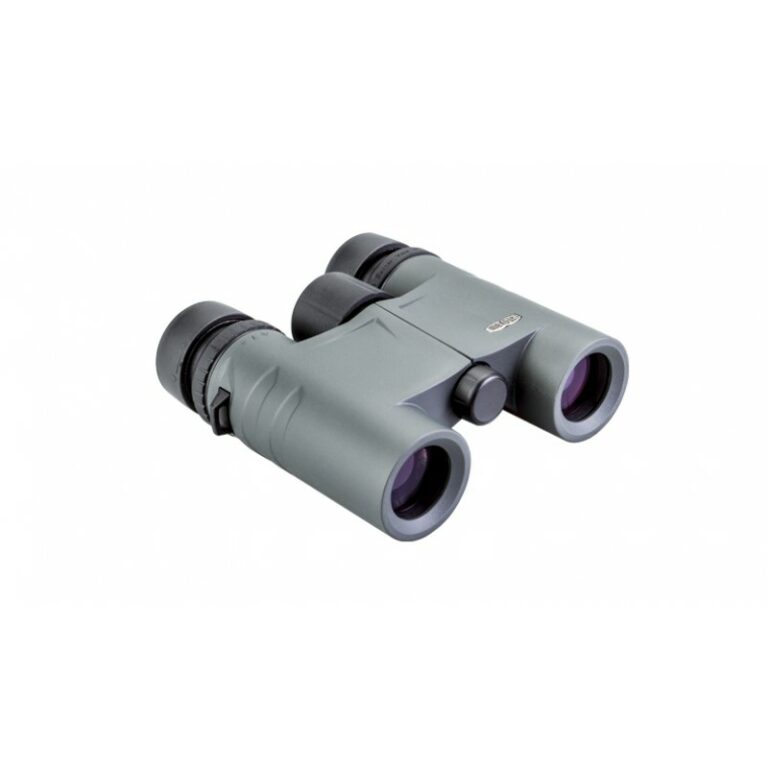
PORTUGAL
Leica is presently the only sports optics manufacturer that has a presence in both Germany and Portugal.
-
LEICA
Following an overwhelming response to cameras, microscopes, and sports optics in the 1970s, Leica established a production facility in Vila Nova de Famalicão near Porto, Portugal to handle some of the workloads. The new factory initially produced microscopes, but seeing its productivity, Leica Wetzlar shifted the manufacturing operations of the R-series camera ‘Leica R3” to Portugal in 1976. The factory saw expansions in 1981 and 1988 to accommodate the manufacturing of additional M-series cameras and laser rangefinders.

In 2014, Leica established a new factory in the same location to further enhance the production capacity in Portugal. Several new products, including riflescopes, digital cameras, and binoculars are produced in the new Famalicão plant, which employs over 700 employees. Unlike other European brands, the Portugal factory is fully regulated by Leica Camera AG and therefore, the company boasts identical manufacturing and quality control standards at both Wetzlar and Porto locations.
The following binocular models are produced in Famalicao, Portugal:
-
Geovid
Leica is hailed as a market leader when it comes to rangefinders. The Leica Geovid series exhibits unparalleled range finding, exceptional optics, and comfortable handling. Mostly used in hunting and tactical missions, these binoculars offer high colour fidelity and bright images even in low-light conditions, which allows users to take an accurate measurement of the position of their targets. Three versions of Geovid binoculars are currently available: Geovid 3200.com, HD-R 2700, and Geovid R.
-
Trinovid HD
First developed in the 1960s, the Trinovid series exhibits one of the oldest devices to still be produced by Leica. Ever since NASA decided to send one of these binoculars to the moon, the Trinovid HD range has remained an icon of excellence, durability, as well as reliability. All current models feature state-of-the-art optical components, lightweight metal housing, and rubber armour in a compact construction. The compact size makes Trinovid HD suitable for day-long camping and hunting excursions.
-
Ultravid BR, BL, and Silver line
Not to be confused with the Ultravid HD+, the Ultravid series features particularly small binoculars which are designed to fit in jacket pockets and be easily carried everywhere. Unlike portable binos from other brands, the small size of Ultravid binoculars does not come in the way of Leica’s excellent optical performance and built quality.
ROMANIA
There has not been much development in the optics area in the Eastern European region, which is why most countries have one or two sports optics companies. In Romania, binoculars from IOR are quite popular.
-
IOR
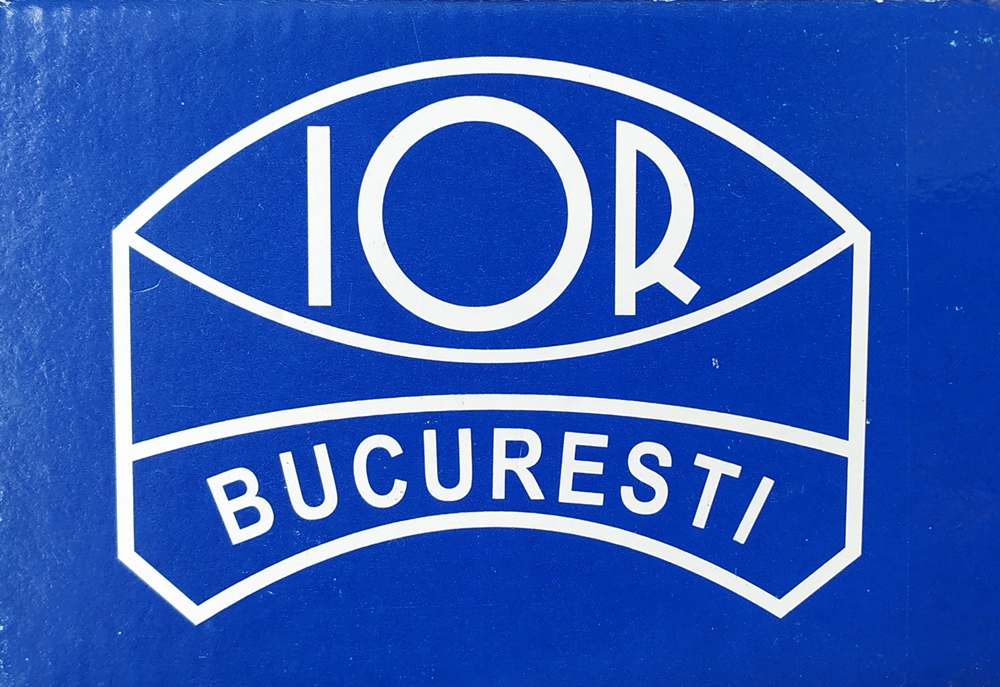
IOR, short for Întreprinderea Optică Română, is among the leading sports optics manufacturers in Europe.
History
With its headquartered in Bucharest, Romania, the company was originally established as a producer of premium optics for various devices, such as telescopes, eyeglasses, and microscopes, but it went on to introduce several products, such as photographic cameras, lasers, optoelectronics, and thermal vision systems in the 1970s.
Military-grade Binoculars
During WWII, IOR manufactured military-grade scopes for the armed forces. The scopes garnered recognition for their optical performance during warfare, which the company still retains to this day. In response to the widespread appreciation, IOR continued the production of military-grade IOR-VALDADA B/GA 7×40 binoculars and riflescopes for hunting and tactical markets.
Although the production takes place in Romania, IOR binoculars are equipped with a Schott glass (acquired from Schott AG), which is one of the reasons behind their optical excellence. Available binoculars are authentic Romanian Army surplus and are fitted with BAK4 Porro prisms, protective rubber coating, and an individual focusing system.
BELARUS
Currently, BelOMO is the only producer of sports optics based in Belarus.
-
BELOMO

BelOMO, short for Belarus Optiko Mechanichesckoye Obyedinenie, is a notable manufacturer of laser, optomechanical and optoelectronic equipment.
History and Production Facility
The company was originally founded with the name Minsk Mechanical Works in 1957 and has been operating in the Minsk region ever since. The Minsk factory is equipped with several in-house production capabilities, such as a foundry, stamping press, and galvanic station, in addition to CNC milling and assembly equipment. The establishment also includes a testing station and some research and development laboratories.

Binoculars
BelOMO currently offers three variants in the binoculars segment, VKB-7, 7×42 Prism, and BKTS 7×18 binoculars. All three models are produced in Belarus and feature anti-reflective lens coatings and a Nitrogen-purged optical housing.
RUSSIA
Russia is home to two sports optics manufacturers, namely Baigish and Kenko.
-
BAIGISH
Baigish is a popular Russian sports optics manufacturer that produces military and civilian-grade binoculars, riflescopes, and monoculars. Located in Kazan, Russia, Biagish produces several variants of binoculars in multiple configurations for hunting and sightseeing. All binoculars are based on the classical Porro-prism design.
Binoculars
Biagish currently produces the following binoculars: BPOs 10×42, BPOs 7×30, BPS 10×40, BPC5 8x30M, BPC 10×40, BPC 15×50, BPC2 10×40, BPC2 12x45M, BPC3 12×45, BPC5 8x30M, BPC6 8×30, BPC7 8×30.
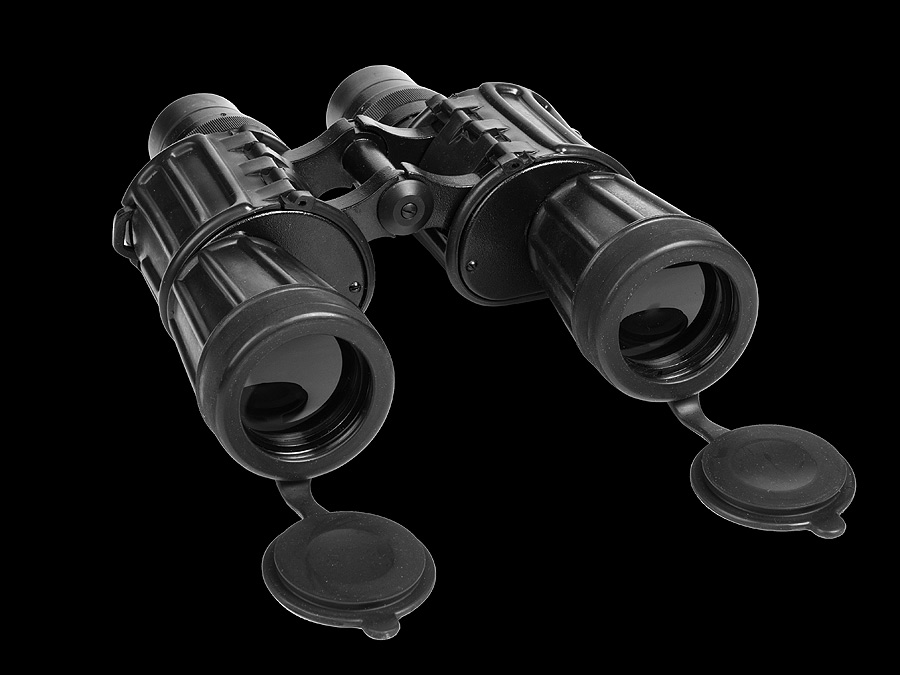
The BPOs 10×42, BPOs 7×30, BPC2 10×40, BPC3 12×45, BPC6 8×30 binoculars come with a protective rubber coating. Three binoculars BPs 10×40, BPOs 10×42, and BPOs 7×30 are equipped with an individual focus system. Regardless of the features, Biagish binoculars lie in the affordable devices segment, which makes them perfect for entry-level users.
CONCLUSION
Although binoculars are now produced in all parts of the world, European binoculars are still considered a synonym for premium quality and performance. They did not gain this recognition overnight – it was gained as a result of years of innovation, research, and dedication in the field of optics. In recent years, several contenders, especially from Europe and Asia, have achieved a standard of quality where their products can be compared to European standards, but there is still a lot of ground to cover.
The invention of the very first pair of binoculars is credited to Europe. Why? Because Johann Lippershey, a German-Dutch optical scientist was the first person to come up with the idea of a bi-ocular device in 1608. The device saw several improvements until it was perfected to its present form by an Italian scientist, Igancio Porro, in 1854. Additionally, all major breakthroughs in the field of optics took place in Europe, such as Nitrogen-Purging by Steiner, Abbe-Koenig prisms by Zeiss, and Porro prisms by Ignacio Porro.
Some European brands take advantage of this widespread impression by rebranding outsourced binoculars produced in Asian countries to that of their own. To save yourself from this scam, proper knowledge about manufacturers and their products must be acquired before making any purchase.



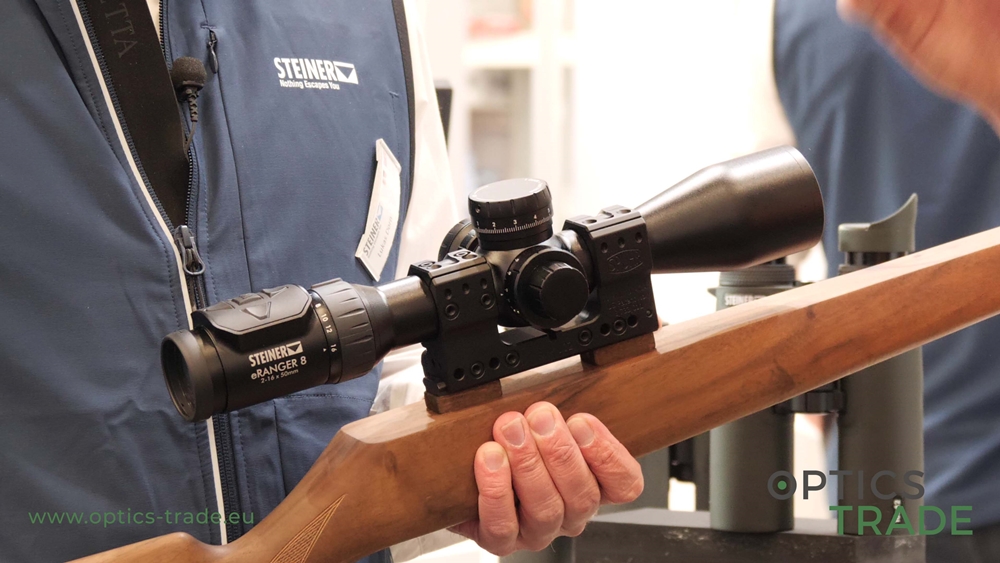
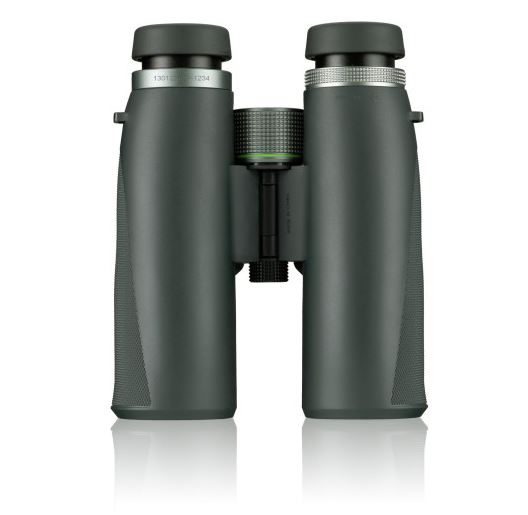


Thanks. This article is highly informative. I have bought a Steiner 8×42 safari binoculars as I wanted a German made optics. Did I make the right choice?
Thanks a lot.
Hi, Teodor.
Thank you for your work. I just wonder: you didn’t mention EISCHENBACH in your materials. I’m not in the field, just a beginner reading materials before buying an object. Also it would be of interest to read something about UK binoculars. Concerning URSS binoculars too (as you know, there is a market for collectors of old objects, and many people are deceived by scammers, due to the lack of information). In case you are interested to perfect your work… Thank you.